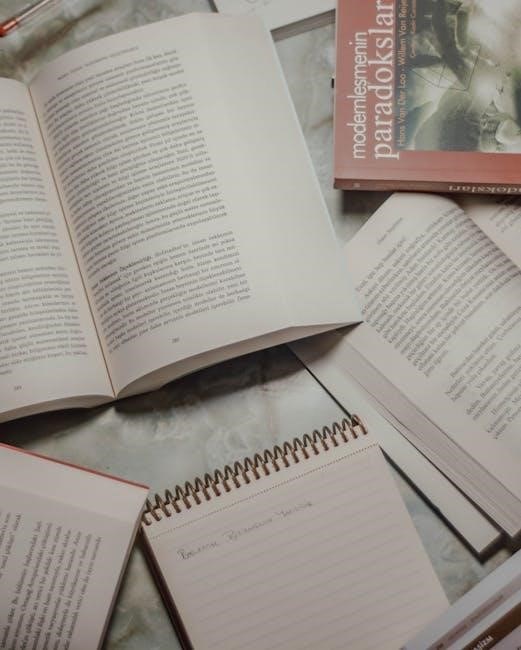A literary analysis essay is a structured academic writing piece that examines a literary work’s themes, characters, or symbols. It requires critical thinking and close reading to interpret texts effectively, often following a clear structure with an introduction, body paragraphs, and a conclusion.
Overview of Literary Analysis Essays
A literary analysis essay is a written piece that interprets, evaluates, and analyzes a literary work or a specific aspect of it. It requires a close reading of the text to uncover themes, motifs, or symbols. The essay typically includes an introduction, body paragraphs, and a conclusion. Each body paragraph focuses on a single idea supported by textual evidence. The goal is to demonstrate a deep understanding of the text and present a well-supported argument. This format helps readers engage with the analysis critically.
Importance of Literary Analysis in Academic Writing
Literary analysis is a cornerstone of academic writing, fostering critical thinking and analytical skills. It enables students to engage deeply with texts, exploring themes, characters, and symbols. By practicing close reading and evidence-based argumentation, writers refine their ability to articulate ideas clearly. This skillset is essential for various disciplines, as it promotes effective communication and logical reasoning. Mastering literary analysis prepares students for advanced academic challenges and enhances their understanding of diverse perspectives in literature. It is a vital tool for intellectual growth and academic success.
Understanding the Structure of a Literary Analysis Essay
A literary analysis essay typically includes an introduction, body paragraphs, and a conclusion. It avoids organizing by plot structure, focusing instead on thematic or analytical frameworks.
Key Components of a Literary Analysis Essay
A literary analysis essay consists of several essential elements, including a clear thesis statement, detailed analysis of themes or characters, and supporting textual evidence. Each body paragraph should focus on a specific argument, backed by quotes or examples from the text. Additionally, providing contextual information about the work enhances understanding. The essay should also include a strong introduction and conclusion, with the latter summarizing key insights without introducing new ideas. Proper structure ensures clarity and coherence.
The thesis statement serves as the foundation of a literary analysis essay, guiding the reader through the argument. It must be concise yet specific, clearly presenting the essay’s central claim. A strong thesis statement sets the tone for the analysis, ensuring all subsequent arguments and evidence align with it. By narrowing the focus, it helps maintain coherence and direction, making the essay more engaging and academically robust. A well-crafted thesis is essential for a compelling literary analysis. Choosing a literary work for analysis involves selecting a text that offers depth and complexity, allowing for meaningful interpretation and exploration of themes and elements. Selecting a suitable text for literary analysis involves identifying works with rich themes, complex characters, and layered meanings. It’s essential to choose a text that allows for in-depth exploration and supports a clear argument. Consider the length and accessibility of the text, ensuring it aligns with your analytical goals and audience. A text with multiple interpretations often yields a compelling analysis, enabling you to demonstrate critical thinking and insightful commentary.
When selecting a literary work for analysis, consider its thematic depth and complexity. Choose texts with well-developed characters and symbolic elements that allow for interpretation. Accessibility is crucial; the work should be understandable but also challenging enough to warrant analysis. Additionally, align the text with your academic goals and audience, ensuring it supports a strong argument. Avoid overly simplistic texts and opt for works that offer multiple perspectives, fostering a nuanced and engaging literary analysis. A strong thesis statement guides the essay’s focus, presenting a clear argument about the literary work. It should be specific, arguable, and supported by evidence, shaping the essay’s direction effectively. An effective thesis statement is clear, concise, and specific, providing a roadmap for the essay. It should be arguable, offering a unique perspective on the literary work, and supported by textual evidence. A strong thesis avoids vague language, ensuring the essay remains focused and coherent. It also guides the reader through the analysis, establishing the essay’s purpose and direction from the outset. Properly crafted, it sets the foundation for a compelling literary analysis. A strong thesis statement in literary analysis might argue, “In To Kill a Mockingbird, Harper Lee uses Scout’s character development to explore racial injustice and moral growth.” Another example could be, “Through the use of symbolism in The Great Gatsby, F. Scott Fitzgerald critiques the American Dream’s illusion of social mobility.” These statements are specific, arguable, and provide a clear focus for the essay, guiding the analysis and ensuring a cohesive argument. They demonstrate how to effectively frame a literary analysis. Creating a detailed outline is essential for organizing ideas logically. It typically includes an introduction, thesis statement, body paragraphs with evidence, and a conclusion. This structure ensures clarity and coherence. A detailed outline for a literary analysis essay ensures a structured approach. Start with the introduction, including background and thesis. Body paragraphs should each focus on a specific theme or element, supported by textual evidence. Each paragraph should have a topic sentence, analysis, and evidence. The conclusion should summarize key points and restate the thesis. Subheadings can be used to break down sections further, enhancing readability. This method helps maintain coherence and depth. Organizing ideas and arguments in the outline is crucial for a logical flow. Start with broad categories like introduction, body, and conclusion. Within each, break down into smaller sections, such as themes, character analysis, or symbols. Ensure each section supports the thesis statement. Use subpoints to detail evidence and analysis, maintaining a clear hierarchy. This structure helps in presenting arguments cohesively, making the essay easier to follow and more persuasive. Proper organization enhances clarity and impact. The introduction sets the tone for your essay, providing background on the literary work and presenting your thesis statement. It should engage readers and establish the essay’s focus, ensuring a smooth transition into the analysis. A strong introduction captivates readers and sets the stage for your analysis. Begin with a hook—such as a thought-provoking question, a quote, or a surprising fact—to engage your audience. Provide essential context about the literary work, including its title, author, and relevant background. Conclude the introduction with a clear and concise thesis statement that outlines your main argument. Ensure your thesis is specific and directly addresses the focus of your analysis, guiding the reader through your essay’s structure. When introducing the literary work, provide readers with essential details about the text, including the title, author, publication date, and historical context. This background information helps establish relevance and sets the foundation for your analysis. Mention the genre, such as novel, poem, or play, and highlight key themes or motifs that are central to your argument. Additionally, briefly discuss the author’s background or any cultural influences that shaped the work, ensuring readers understand its significance before delving into your analysis. Close reading involves a meticulous examination of a text to uncover deeper meanings, themes, and literary devices. Pay attention to language, structure, and context to interpret the author’s intent and identify patterns or motifs that contribute to the overall narrative or message. This process is essential for developing a nuanced and insightful literary analysis. Effective close reading involves several key techniques. First, carefully read and annotate the text, highlighting significant passages and noting recurring motifs or themes. Next, analyze word choice, syntax, and figurative language to understand the author’s tone and intent. Additionally, examine the structure of paragraphs and chapters to identify relationships between ideas. Comparing and contrasting characters or events can also reveal deeper meanings. Finally, consider the historical and cultural context to enrich your interpretation. By employing these strategies, you can uncover rich layers of meaning in the text. In literary analysis, themes are central ideas explored in a text, while motifs are recurring patterns that reinforce these themes. Symbols are objects or images representing abstract concepts. To identify these elements, look for repetition and their significance. For example, a recurring motif of light may symbolize hope or truth. Themes often emerge from the interplay of these elements. Analyzing how they connect helps uncover the author’s message, providing a deeper understanding of the text’s meaning and resonance. This enhances your ability to interpret and critique the work effectively. Always consider context. Character development is a crucial aspect of literary analysis, involving the examination of how characters evolve, their motivations, and interactions, providing insights into the narrative’s themes. Each paragraph can focus on different aspects of growth, as seen in example essays. Analyzing character dynamics involves examining dialogue, interactions, and conflicts to understand their roles and growth. Close reading of text reveals motivations and relationships, while comparative analysis highlights changes over time. Using examples from literary essays, one can identify methods like character mapping and psychological analysis to deepen understanding. These techniques help uncover underlying themes and provide a comprehensive view of character development within the narrative structure. Examining character relationships and conflicts reveals deeper themes and motivations in a literary work. By analyzing dialogue and interactions, readers can uncover tensions, alliances, and power dynamics. Conflicts often drive the plot and character development, showcasing how individuals grow or change. Effective analysis involves identifying key moments where relationships shift, using textual evidence to support interpretations. This approach enhances understanding of the narrative’s emotional and psychological layers, as demonstrated in literary analysis essay examples. Literary analysis essays often explore themes and symbols to uncover deeper meanings. Themes represent central ideas, while symbols convey hidden messages. Analyzing these elements reveals the author’s intent and enriches understanding of the text. By identifying recurring motifs and interpreting their significance, readers gain insights into the work’s broader implications. This method is essential for crafting a compelling literary analysis, as shown in example essays. Identifying underlying themes in a literary work involves analyzing recurring patterns and ideas. Themes often reflect universal truths or societal concerns. By closely examining dialogue, setting, and character interactions, readers can infer deeper meanings. For instance, themes of love, identity, or justice may emerge through repeated motifs or symbolic elements. Analyzing these themes provides insight into the author’s message and enhances the reader’s understanding of the text. Example essays demonstrate how to effectively uncover and interpret these themes. Symbols in literature carry meanings beyond their literal interpretation. They enrich the narrative by representing ideas, emotions, or concepts. For example, a rose might symbolize love, while a crown could represent power. Interpreting symbolism involves connecting these elements to the broader themes of the text. Effective analysis explores how symbols contribute to the story’s depth and the author’s intended message. Example essays illustrate how to decode these symbols, revealing their significance and enhancing the reader’s comprehension of the literary work. Evidence and examples are crucial for supporting arguments in a literary analysis. They provide concrete proof from the text, strengthening the essay’s credibility and depth. Textual evidence is essential for building credible arguments in a literary analysis. By quoting or paraphrasing specific passages, writers demonstrate their understanding of the text. Proper citation practices, such as using page numbers or line references, enhance academic integrity. Effective use of evidence ensures that arguments are grounded in the text itself, making the analysis more persuasive and aligned with scholarly standards. This approach fosters a deeper engagement with the material. Effective integration of textual evidence involves seamlessly weaving quotes or paraphrased content into the analysis. For instance, citing specific dialogue demonstrates character motivations, while referencing descriptive passages highlights themes. Proper contextualization explains how the evidence supports the argument. A strong example might analyze a protagonist’s internal conflict by quoting their pivotal monologue and linking it to broader themes. This method ensures clarity and reinforces the essay’s central claims, providing readers with a compelling and evidence-based narrative. The conclusion summarizes key points, reiterates the thesis, and reflects on the analysis’s significance, providing a meaningful closure to the essay without introducing new ideas. A strong concluding paragraph effectively summarizes the main arguments and reiterates the thesis statement. It provides a final perspective on the analysis, ensuring the essay ends cohesively. Avoid introducing new ideas; instead, reflect on the significance of the analysis and its implications. Use clear, concise language to reinforce the essay’s central theme, leaving the reader with a lasting impression of the literary work’s impact and your interpretation. Summarizing key points and reiterating the thesis is essential for a cohesive conclusion. Briefly revisit the main arguments and evidence presented, ensuring alignment with the thesis. Avoid redundancy; instead, synthesize the analysis to highlight its significance. The thesis restatement should reflect the essay’s focus, reinforcing the central argument. This approach ensures clarity and leaves the reader with a clear understanding of the essay’s purpose and findings, tying all elements together effectively. Reviewing and revising are crucial steps in refining a literary analysis essay. Ensure clarity, coherence, and proper grammar by carefully reading through the draft. Revise any unclear phrases or weak arguments to strengthen the analysis. Pay attention to sentence structure and flow, making sure each paragraph transitions smoothly to the next. This process helps in presenting a polished and logically sound essay that effectively communicates the intended message to the reader. When revising a literary analysis essay, focus on clarity, coherence, and grammar. Review each paragraph to ensure it supports the thesis and flows logically. Check for consistency in tone and style, and eliminate any redundancies. Pay attention to sentence structure and word choice to enhance readability. Use specific examples from the text to reinforce arguments and ensure all claims are well-supported. Finally, proofread for any grammatical errors to present a polished and professional essay. Clarity and coherence are essential for a compelling literary analysis essay. Ensure each sentence conveys a single, clear idea and that paragraphs transition smoothly. Use precise language to avoid ambiguity and maintain a consistent tone throughout. Grammar and punctuation must be flawless to maintain credibility. Read the essay aloud to detect awkward phrasing and revise as needed. A well-structured and grammatically correct essay enhances the reader’s understanding and strengthens the argument presented in the literary analysis.The Role of the Thesis Statement in Literary Analysis

Selecting a Literary Work for Analysis
How to Choose a Suitable Text for Literary Analysis
Factors to Consider When Selecting a Literary Work
Developing a Strong Thesis Statement
Characteristics of an Effective Thesis Statement
Examples of Strong Thesis Statements in Literary Analysis
Outlining the Essay
Creating a Detailed Outline for a Literary Analysis Essay
Organizing Ideas and Arguments in the Outline
Introducing the Literary Work and Its Context

Conducting a Close Reading
Techniques for Close Reading in Literary Analysis
Identifying Key Themes, Motifs, and Symbols
Analyzing Character Development
Methods for Analyzing Character Dynamics
Exploring Character Relationships and Conflicts

Examining Themes and Symbolism
Uncovering Underlying Themes in the Text
Interpreting Symbolism and Its Significance
Incorporating Evidence and Examples
Using Textual Evidence to Support Arguments
Examples of Effective Evidence Integration
Writing the Conclusion
Crafting a Strong Concluding Paragraph
Summarizing Key Points and Reiterating the Thesis

Reviewing and Revising the Essay
Best Practices for Revising a Literary Analysis Essay
Ensuring Clarity, Coherence, and Grammar
